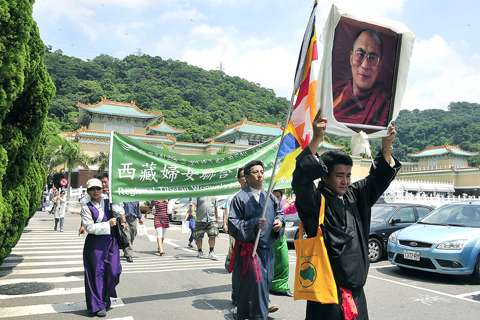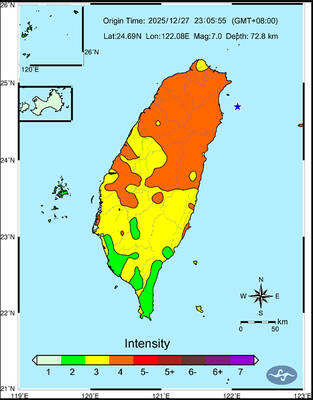Shouting matches and minor clashes erupted at the National Palace Museum yesterday after officials turned down a request by Tibetans and activists to present a photo of the Dalai Lama to “fill the missing part” of an exhibition on Tibetan Buddhist art.
“The Dalai Lama is the highest spiritual leader in Tibetan Buddhism. How could a portrait of the Dalai Lama be missing at an exhibition about Tibetan Buddhism?” asked Regional Tibetan Youth Congress-Taiwan (RTYC-Taiwan) chairman Tashi Tsering, wearing a traditional Tibetan outfit and holding up a large portrait of the Dalai Lama.
Several police officers stood in front of Tashi and other activists, blocking their attempt to enter the exhibition with the picture, asking them to leave immediately.

PHOTO: CHEN YI-CHUAN, TAIPEI TIMES
“If you accept the portrait, we will leave right away,” Tashi said.
Police refused the request, with one officer saying they would not allow anyone to take “that thing” — referring to the Dalai Lama’s portrait — into the venue.
The remarks were not well received by the Tibetans.
“It’s not ‘a thing,’ it’s a portrait of the Dalai Lama, the highest figure in our religion,” they said.
The standoff lasted about 20 minutes.
Police said the activists were in violation of the Assembly and Parade Act (集會遊行法) because they had not applied to hold a political rally. The Tibetans countered that their action was religious as they were there to defend their religion, adding that by law, an assembly and parade permit is not required for religious activities.
“We’re all about religion, it’s the Chinese government that’s trying to politicize everything,” RTYC-Taiwan vice-chairman Tenzin Chunpel said. “They are trying to reinforce the impression that Tibet has always been part of China through this exhibition, that’s why they’re purposely avoiding talking about the Dalai Lama in the exhibition.”
“If we have to apply to deliver a portrait of the Dalai Lama, who applied to the Tibetans to take these pieces of art — which belong to all Tibetans — to an exhibition outside of Tibet?” Chunpel said.
Students for a Free Tibet-Taiwan spokeswoman Jade Kuo (郭聖潔) said items in the exhibition “were stolen by the Chinese government from the Tibetans when they invaded Tibet in the 1950s.”
Although police said the activists should have applied for a permit before the demonstration, an officer told the Taipei Times it would not have been approved even if they had applied.
“We could not possibly have approved the application because it involved politics,” the officer said.
The officer could not explain why, if the application for the rally had been political in nature, it would have been turned down.
“You ask me based on which law?” he said. “Well, maybe I should not answer this question.”
Museum Southern Branch deputy director Lin Chen-feng (林振豐), who is in charge of the exhibition venue, said the museum would only deal with purely cultural and artistic issues.
“[The activists’] demands are political. That’s not something I can respond to,” he said.
Asked why a portrait of the Dalai Lama could not be considered a piece of art, Lin said he did not consider a person’s portrait art.
Failing to receive a positive response from the museum, the Tibetans and their supporters sat down to recite Buddhist chants and sing the Tibetan national anthem before leaving.

A magnitude 7.0 earthquake struck off Yilan at 11:05pm yesterday, the Central Weather Administration (CWA) said. The epicenter was located at sea, about 32.3km east of Yilan County Hall, at a depth of 72.8km, CWA data showed There were no immediate reports of damage. The intensity of the quake, which gauges the actual effect of a seismic event, measured 4 in Yilan County area on Taiwan’s seven-tier intensity scale, the data showed. It measured 4 in other parts of eastern, northern and central Taiwan as well as Tainan, and 3 in Kaohsiung and Pingtung County, and 2 in Lienchiang and Penghu counties and 1

FOREIGN INTERFERENCE: Beijing would likely intensify public opinion warfare in next year’s local elections to prevent Lai from getting re-elected, the ‘Yomiuri Shimbun’ said Internal documents from a Chinese artificial intelligence (AI) company indicated that China has been using the technology to intervene in foreign elections, including propaganda targeting Taiwan’s local elections next year and presidential elections in 2028, a Japanese newspaper reported yesterday. The Institute of National Security of Vanderbilt University obtained nearly 400 pages of documents from GoLaxy, a company with ties to the Chinese government, and found evidence that it had apparently deployed sophisticated, AI-driven propaganda campaigns in Hong Kong and Taiwan to shape public opinion, the Yomiuri Shimbun reported. GoLaxy provides insights, situation analysis and public opinion-shaping technology by conducting network surveillance

Taiwan is gearing up to celebrate the New Year at events across the country, headlined by the annual countdown and Taipei 101 fireworks display at midnight. Many of the events are to be livesteamed online. See below for lineups and links: Taipei Taipei’s New Year’s Party 2026 is to begin at 7pm and run until 1am, with the theme “Sailing to the Future.” South Korean girl group KARA is headlining the concert at Taipei City Hall Plaza, with additional performances by Amber An (安心亞), Nick Chou (周湯豪), hip-hop trio Nine One One (玖壹壹), Bii (畢書盡), girl group Genblue (幻藍小熊) and more. The festivities are to

AFTERMATH: The Taipei City Government said it received 39 minor incident reports including gas leaks, water leaks and outages, and a damaged traffic signal A magnitude 7.0 earthquake struck off Taiwan’s northeastern coast late on Saturday, producing only two major aftershocks as of yesterday noon, the Central Weather Administration (CWA) said. The limited aftershocks contrast with last year’s major earthquake in Hualien County, as Saturday’s earthquake occurred at a greater depth in a subduction zone. Saturday’s earthquake struck at 11:05pm, with its hypocenter about 32.3km east of Yilan County Hall, at a depth of 72.8km. Shaking was felt in 17 administrative regions north of Tainan and in eastern Taiwan, reaching intensity level 4 on Taiwan’s seven-tier seismic scale, the CWA said. In Hualien, the